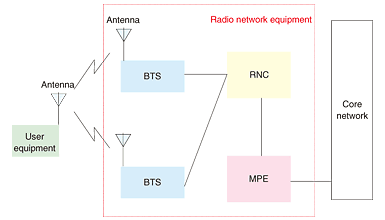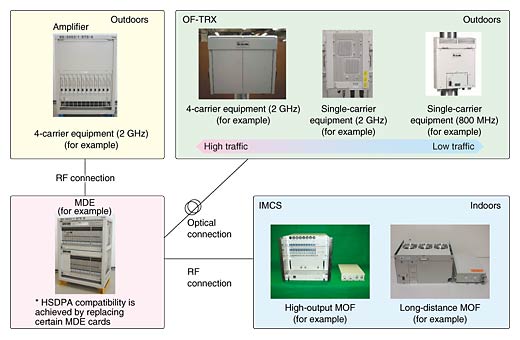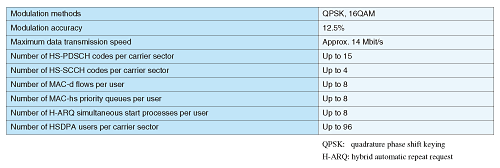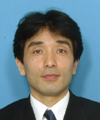 |
|||||||||||||||||||||||||||
|
|
|||||||||||||||||||||||||||
Vol. 5, No. 4, pp. 31–34, Apr. 2007. https://doi.org/10.53829/ntr200704sf4 Development of HSDPA Radio Network EquipmentAbstractThis article describes the development of HSDPA functions for the radio network systems of NTT DoCoMo's HSDPA (high-speed downlink packet access) service. 1. IntroductionOne of the most important issues in rapidly and economically expanding the service area of HSDPA (high-speed downlink packet access), which was introduced in August 2006, is to implement HSDPA functions with minimal changes to existing radio access network systems (Fig. 1). This article describes the technical characteristics of HSDPA and the methodology for implementing HSDPA functions in the radio network systems, including the base transceiver station (BTS), radio network controller (RNC)*1, and multimedia signal processing equipment (MPE)*2.
2. HSDPA functions in BTSThis section describes how HSDPA functions can be implemented in BTSs. It also describes these HSDPA functions. 2.1 ImplementationThe configuration of the existing 4-carrier 6-sector BTS [5] is shown in Fig. 2. This BTS consists of modulation/demodulation equipment (MDE), a transmission amplifier, an optical feeder transmitter and receiver (OF-TRX)*3, and a radio frequency multi-drop optical feeder (RF-MOF)*4. It flexibly adapts to a wide range of conditions, ranging from low- to high-traffic areas and both indoor and outdoor areas. In the figure, IMCS is the name of a DoCoMo system designed for use in buildings. (It stands for in-building mobile communication system.) To implement HSDPA functions with minimum changes to the 4-carrier 6-sector BTS, we decided to try and implement them by changing only part of the MDE without modifying equipment such as the transmission amplifier or the OF-TRX connected to the MDE. As a result, we were able to implement HSDPA functions by simply replacing certain MDE cards, such as the baseband signal processor card (BB card) and the call processing controller card (CP-CNT card). This required solving several problems. The major one was the need to measure HSDPA transmission power with a transmission time interval*5 of 2 ms. This entailed measuring both the total transmission power and the transmission power used only for HSDPA. The total power had to be measured at very short intervals of 2 ms with existing equipment designed for power measurements at 100-ms intervals. The HSPDA transmission power had to be measured before channel multiplexing. Furthermore, since measurement at the transmission power termination (the conventional measurement point) proved difficult, measurements were taken directly from the BB card, which permitted high-speed measurement with the 2-ms transmission time interval. Newly developed HSDPA-compatible cards have further facilitated the economical implementation of HSDPA functions. By incorporating a high-performance central processing unit (CPU) into the HSDPA CP-CNT card, we doubled the processing capability while achieving a 40% reduction in cost in terms of processing capability per channel. The HSDPA BB card uses a new digital signal processor (DSP)*6 and greater on-chip integration, so the number of channels that can be processed on a single card has almost doubled. Moreover, since existing channels and HSDPA channels can coexist on the same card, baseband resources can be used more effectively. Power consumption per channel has been reduced by approximately 50%, while the cost per channel has been reduced by approximately 30%.
2.2 Basic specificationsThe basic HSDPA specifications for the BTS are given in Table 1. In line with the introduction of HSDPA, radio characteristics are now compatible with 16QAM*7 (16 quadrature amplitude modulation), and the modulation accuracy*8 satisfies the 12.5% requirement. HS-PDSCH can support up to 15 codes per carrier sector, and it is applicable to all HS-DSCH physical layer categories (categories 1-12) defined by 3GPP (3rd Generation Partnership Project). Up to 96 HSDPA users may be accommodated per carrier sector, and a maximum transmission data rate of approximately 14 Mbit/s is possible. To ensure compatibility with new services, up to 8 MAC-d flows*9 and MAC-hs priority queues*10 may be allocated per user. In addition to the basic specifications, the BTS has the following supplementary features. (1) Once the HSDPA card has been installed in place of the previous MDE card, the HSDPA service can be started after making only limited changes to the system data without having to change the software. (2) Channel allocation control is implemented to ensure as far as possible that a spare HSDPA BB card is available. In the event of a card failure, an existing channel and an HSDPA channel are switched at high speed to the spare HSDPA BB card to permit uninterrupted communication. Table 1. Basic HSDPA specifications for BTS.
3. Implementation of HSDPA functions in RNC and MPEAs with BTS, when HSDPA functions were implemented in RNC and MPE, special effort was made to enable existing systems to be utilized as much as possible to ensure rapid and economical expansion of the service area. This section describes how HSDPA functions were implemented in RNC and MPE. It also describes these functions. 3.1 RNCHSDPA functions can be added to the existing RNCs by simply adding a high-speed data processing unit (HSDPU). This is either an HSDPU module or an HSDPU card. The primary functions of the HSDPU are to receive data frames from the MPE, convert them into HS-DSCH data frames, and then send these HS-DSCH data frames to BTSs. HSDPU also converts and relays control signals for flow control between the BTSs and MPE (capacity allocation signal and capacity request signal). It has a maximum uplink data rate of 384 kbit/s per user. To support future enhancement, a maximum downlink data rate of approximately 14 Mbit/s is possible without hardware modification. 3.2 MPEHSDPA functions were implemented in MPE by simply adding a new signal processing card, called SPUHSP (signal processing unit for high-speed packets). This provides greater processing speed than the existing SPUVOD (signal processing unit for voice/data) card. Its functions are to receive the capacity allocation signal, which is a flow control signal sent from BTS, to control the transmission volume of the downlink data at the specified transmission speed, and to send a capacity request signal to BTS. SPUHSP provides increased user capacity per card and a tenfold increase in the data transmission capacity compared with the existing SPUVOD card. The maximum uplink data rate is 384 kbit/s per user. To support future enhancement, a maximum downlink data rate of approximately 14 Mbit/s is possible without hardware modification. 4. ConclusionThis article described how HSDPA functions have been implemented in BTS, RNC, and MPE. References
|
|||||||||||||||||||||||||||












